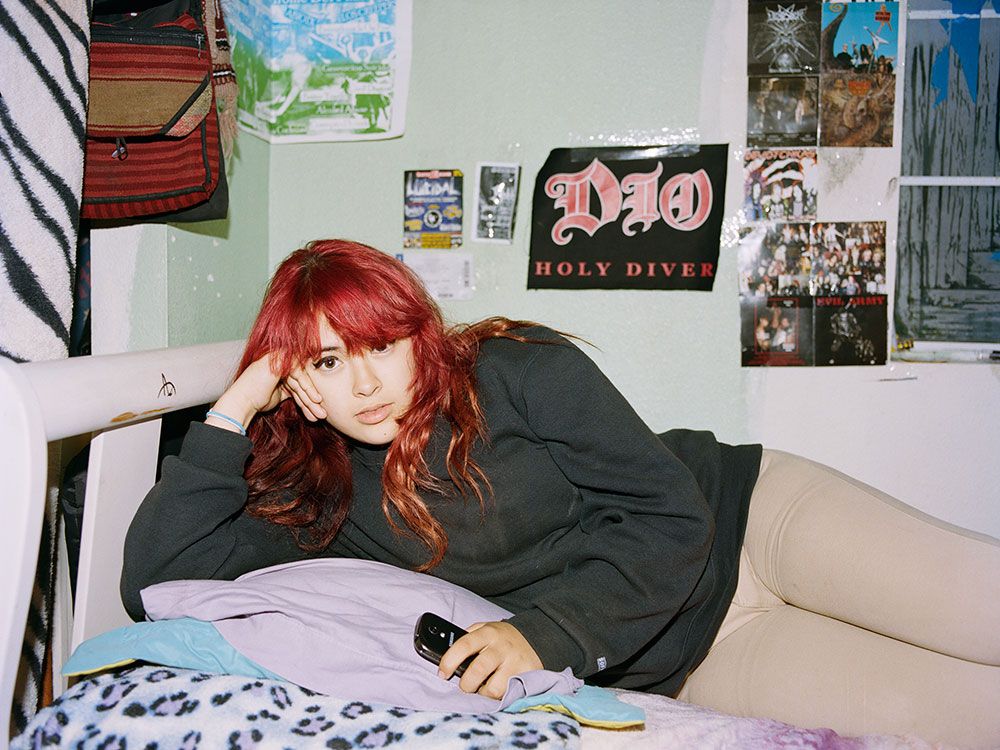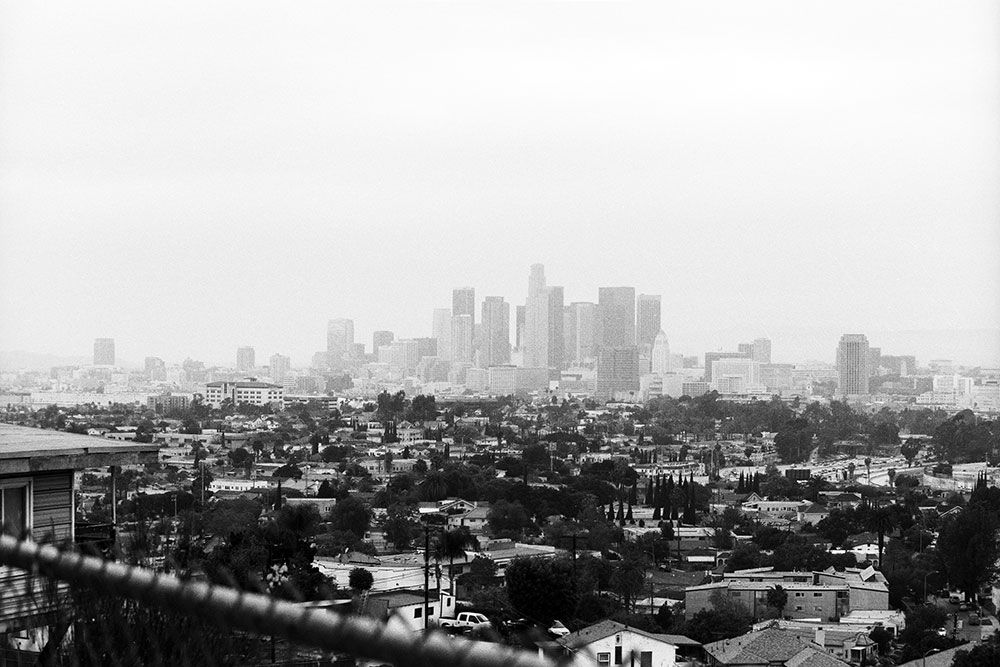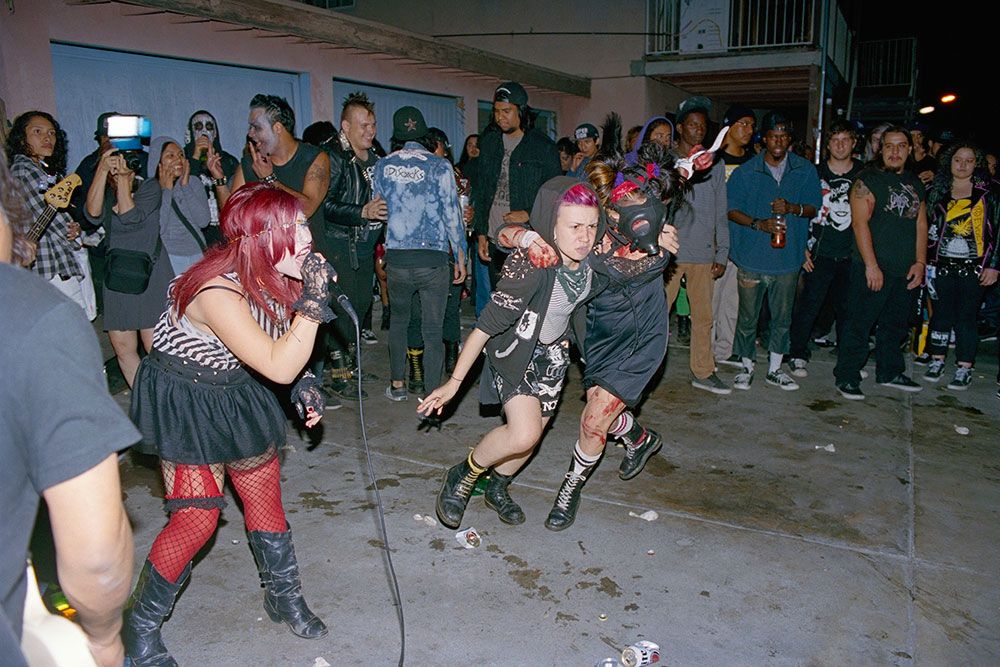Patios traseros de casas y parkings conforman el espacio en el que se desarrolla Los punks, el documental de Ángela Boatwright sobre la escena DIY punk de Los Ángeles.
Este documental puede interpretarse como respuesta a una sociedad cada vez mas estandarizada y aburrida, donde parece que no ocurre nada. Y vaya si ocurre…cada fin de semana, de forma totalmente autogestionada, cientos de punks se concentran para asistir a este tipo de conciertos. Ángela nos enseña lo que la mayoría de las veces esta oculto, la realidad de una escena musical totalmente underground. No esperes ningún tipo de cobertura mediática, ni el apoyo de ninguna sala. Centrándose en la vida de varios de sus protagonistas (promotores, músicos, participantes) el documental nos enseña los anhelos y aspiraciones de estos jóvenes punks que solo intentan buscar su lugar en el mundo.
¿Dónde está filmado Los Punks?
Los Punks se rodó en Boyle Heights, al Este de Los Ángeles, South Central y Watts California.
Gran parte de tu trabajo fotográfico ha estado muy centrado en las subculturas juveniles
La verdad, es que no estoy muy seguro de por qué. Aún tengo una conexión muy potente con aquella época de mi vida. Me sentía muy solo durante mi juventud y tomar fotos era una manera de salir de mi cascarón. Nunca olvidaré ese sentimiento de soledad y creo que muchos jóvenes se sienten de esa manera. Crecí participando de muchas de esas subculturas, ya que en el lugar donde vivía todos los chicos “outsider” pasaban mucho tiempo juntos. A mis amigos les encantaba el punk, el metal, el hardcore, el rap…eran grafiteros, skaters y raveros y yo, era el fotógrafo. Quedaba con ellos y lo documentaba todo. Según iba creciendo, continué captando exactamente las mismas escenas. Básicamente, estoy haciendo lo mismo que hacía cuando tenía 16 años pero en una escala mayor.
¿Qué fue exactamente lo que te llevó a interesarte por la escena punk latina en Los Ángeles?
Pasó de una manera muy natural. Me mudé a Los Ángeles y, unos meses después, Vans me preguntó por la creación de un documental de episodios Web para ellos. Les gustaban mis trabajos anteriores y querían que les propusiese algunas ideas. Sabía que Los Ángeles tenía una increíble y dinámica historia punk, así que empecé a investigar; quería saber lo que estaba pasando ahora. Fui a mi primer concierto y todo vino rodado desde ahí. Reconozco que estaba obsesionado con la energía que se respiraba en los conciertos que me costó darme cuenta varios meses que sus asistentes eran latinos.

Teniendo en cuenta que dicha escena punk es totalmente autosuficiente y desconfiada con los extraños ¿fue difícil ganarse su confianza?
Sí y no, la escena cuenta no con cientos, sino con miles de personas así que es absolutamente imposible ganarse la confianza de todo el mundo.
Este tipo de escenas suelen ser efímeras: los grupos vienen y van, la gente cambia de gusto musical o simplemente crece ¿qué buscabas contando sus historias?
Queríamos mostrar la variedad que existe dentro de la escena, queríamos contar diferentes historias. Quería asegurarme que las mujeres aparecieran también. Los Punks es una captura de lo que estaba pasando en un punto muy específico. Si hubiera comenzado a grabar en cualquier otro momento, incluso una o dos semanas antes o después, la película hubese sido completamente diferente.

Realmente esta escena ha llevado otra vez a muchos chicos de clase obrera a los conciertos, muchos de ellos hijos de inmigrantes ¿ves a chicos blancos en los conciertos
Sin duda, hay todo tipo de gente en los backyard shows. Los Punks ha sido descrita como “la escena punk latina de Los Ángeles”, pero esa definición es absolutamente falsa. Escritores nada documentados y los algoritmos de Netflix han creado esta afirmación en un esfuerzo de describer la película en una o dos frases. Escenas punks en Los Ángeles hay varias y los latinos participan en todas ellas. La escena descrita en Los Punks corresponde a la más callejera y a la más proveniente de los backyard shows. Y sí, chavales blancos también asisten, al igual que afroamericanos, asiáticos, queer y de cualquier otro lugar.
¿Cuánto tiempo tardaste en rodar el documental?
Lo que es la grabación, cosa de un año, pero el proceso de documentación, unos cuatro.

Procedes de la fotografía ¿qué fue lo que te llevo al cine documental?
Antes de mudarme a LA, mientras vivía en Nueva York, compartí oficina con varios profesionales de la industria cinematográfica. Me encanta aprender cosas nuevas y siempre estoy dispuesto a enfrentarme a un reto así que, con su ayuda, comencé a aprender cómo grabar, editar y a cómo crear un documental.
¿Qué conclusiones esperas que saque la gente cuando vean tu película?
No tengo ni idea. Las críticas han sido sorprendentemente buenas pero es imposible predecir que regusto va a dejar en cada boca. Me gusta mucho cómo cada persona que la ve parece tener un “personaje” favorito. Y también, cómo se sienten identificados con diferentes aspectos de la película por muy distintas razones. Me encanta.
Leí que sigues disparando con película ¿qué tipos de cámara utilizas?
Grabo con una carcasa de Nikon FE2 y una cámara de grabación de medio format, una Contax 645 AF. Tengo una cñamara de 4×5 también pero solo la utilicé una vez durante el rodaje. Tengo 41 años, asi que he aprendido a filmar antes de que apareciese lo digital, así que es mucho más natural para mí, sobre todo, cuando grabó en conciertos.

¿Destacarías algún momento en particular del film?
Me encanta la historia de April, sus documentos sobre la escena desde casa, después en un concierto… está todo grabado de una manera muy bella.Pero mi parte preferida viene de la mano de LUIE de SCLA Apparel. LUIE tiene un gran corazón, solo puedo decir cosas positivas sobre él. Es brutal el momento en el que se inclina hacia la cámara mientras es multado por los policías mientras dice “Hater’s gonna hate”, me encanta. Afortunadamente, no tuvo que pagar ninguna multa.
Retratas a la gente con cariño y respeto ¿esperas romper los estereotipos que hay hacia los punks?
No creo que haya derribado ningún estereotipo sobre la gente del punk. Soy una persona de naturaleza curiosa sobre las personas y sus contextos. Todos somos humanos, todos queremos ser amados, encontrar un lugar al que llamar hogar, triunfar, divertirnos, ser parte de una comunidad. Así que aprecio y busco esa humanidad en todo el mundo.

¿Cómo fue el proceso de grabación? Contabas con mucha infraestructura para realizarlo.
Oh, el proceso fue un huracán. Había que dar lo mejor de cada uno en cada preciso instante e intentar mantenernos fríos cuando las cosas iban irremediablemente mal.
El documental refleja muy bien ese ambiente caótico y espontáneo de los conciertos. Algo que llama la atención es a permanente presencia de la policía ¿cómo de habitual es que siempre terminen interrumpiendo los conciertos?
Mucho. La policía hace aparición en el 60% de los conciertos, o incluso más.














English:
LOS PUNKS: THE B-SIDE OF LOS ANGELES
House backyards and parking lots make up the room in which Los Punks, the Angela Boatwright’s documentary about the DIY punk scene of Los Angeles, is developed. This documentary can be translated as a response to an increasingly standardized and boring society, where it seems that nothing happens. But yeah! it happens … actually, every weekend when hundreds of punk attend to self-managed concerts.
Angela shows us what most of the times is hidden: the reality of a totally underground music scene. So do not expect any kind of media coverage or support of any bar. Focusing on the lives of several of its protagonists (promoters, musicians, participants) the documentary shows us the yearnings and aspirations of these young punks who are just trying to find their place in the world.
Where did you film LOS PUNKS?
Los Punks was filmed in Boyle Heights, East Los Angeles, South Central, and Watts California.
Most of your Photo work has been focus on youth subcultures. Please tell us about it, why?
I’m not entirely sure why this is. I’m still a teenager at heart; I’m still very connected to that time of my life. I felt very alone and isolated throughout my youth, taking photos was a way for me to get out of my shell. I never forgot that feeling of loneliness and isolation – I think a lot of teenagers and young people feel this way. And I grew up participating in a handful of “subcultures.” Where I lived, all of the “outsider” kids hung out together. My friends were into punk, metal, hardcore, rap music; they were graffiti artists, skateboarders and ravers, and I was the photographer. I hung out with and documented all of them. As I grew up I continued to document the exact same scenes. Basically I’m doing the same thing now that I did when I was 16 just on a bigger scale.
What was the reason for you to get a big interest in the Latin Punk scene from LA?
It happened fairly organically. I moved to Los Angeles and a few months into my living here Vans asked me to create some documentary webisodes for them, they liked my previous work and wanted me to pitch them some ideas. I knew that L.A. had an incredible, dynamic punk history so I began to investigate; I wanted to see what was happening right now. I went to my first backyard show and it all snowballed from there. Honestly I was so obsessed with the energy at the shows themselves that it took me a few months before I realized that the show-goers were predominantly Latino.
Thinking this scene is very DIY and “non trust” strange people outside the scene. Was hard to win confidence from them?
Yes and no, the scene is hundreds if not thousands of people deep so it’s literally impossible to win everyone’s confidence.
This kind of scenes are a little ephemeral. The groups of people and friends go and back, go and leave, people change the musical taste or they “grow” basically. What you were looking for telling their stories?
We wanted to show variety within the scene, we wanted to tell four different stories. And I wanted to make sure that women were featured as well. Los Punks is a lightning bolt snapshot of what was happening at one very specific moment in time within the scene. If I had started filming at any other time, even a week or 2 before or after, the movie would be completely different.
This scene has got lot of new kids (from the working class ) to gigs, lot of them sons of immigrants. Do you see white kids in this shows?
Of course, all types of people attend backyard shows. Los Punks has been described as “The Latino punk scene in Los Angeles” but that description is entirely false. Un-researched writers and Netflix algorithms have made this claim in an effort to boil down the movie into a one or two sentence description. There are several punk scenes in Los Angeles and Latinos participate in all of them. Latinos make up a majority of the population of the entire city of Los Angeles and as such they participate in every music scene this city has to offer. The punk scene featured in Los Punks is a street punk/ backyard show scene. And yes white kids go to shows as do African American kids, Asian kids, queer kids, every demographic is represented.
How long you take in filming the documentary?
The documentary took a little over a year to finish but I’ve been documenting the scene for over 4 years.
Photography is your background. What was the reason to start filming documentaries?
Before I moved to Los Angeles, while living in New York City, I shared an office space with several professionals in the film industry. I love learning new things and am always up for a challenge so with their guidance I began to learn how to film, edit, and create documentaries.
What conclusions you think the people are gonna get when they watch the film?
I have no idea. So far the reviews have been overwhelmingly positive but I can’t possibly predict what every person will take away from it. I love how everyone seems to have a favorite “character.” Different people identify with different aspects of the film for various reasons. I love that.
I think this one if your first documentary film. What you feel you learned in the process of making?
I’ve learned so many things. I was lucky to have worked with an incredibly talented crew on Los Punks – I couldn’t have asked for a more knowledgeable and hard working team. I learned a lot about story telling from our writer Christine Triano and even more from our talented editor Tyler Hubby. I didn’t realize how much I learned from Tyler (and assistant editor, Louis Lee) until I began editing my first project after Los Punks. I couldn’t believe how much I had picked up from them along the way. Just being a part of such a massive process taught me so many things, I can’t describe each thing individually – I changed as a person and as a creator for the better, no doubt about it.
We have read you still shoot photos with films. What kind of cameras you use? Why?
I shoot with an army of Nikon FE2s and a medium format film camera, Contax 645 AF. I have a 4×5 camera as well but I only brought it out once during the filming of Los Punks. I shoot digital on occasion for various reasons however all of the photographs featured in Los Punks were shot on film. I’m 41 years old so I learned how to shoot with film before digital existed, it’s more natural for me. Especially when shooting live bands and mosh pits.
You highlight any particular time the film?
I love the story of April, his papers on the scene from home after a concert … is all recorded in a very bella.Pero way my favorite part comes from the hand of Louie of ALCS Apparel- Louie has a big heart, I can only say positive things about it. Is brutal the moment he leans towards the camera while he is fined by police while saying “Hater gonna hate”, I love it . Fortunately he not had to pay any fine.
Portray people with love and respect do you expect to break stereotypes there to the punks ?
I do not think he shot down any stereotype about people punk. I am a naturally inquisitive about people and their contexts. We are all human, we all want to be loved, to find a place to call home, to succeed, have fun, be part of a community. So I look for that appreciation and humanity throughout the world.
How was the process of filming? How was your logistic, stuff… To make it happen, cameras, people, team, timing…?
Oh the process is always a hurricane. It’s like herding cats. You do the best you can in the moment and try not to sweat it when things inevitably go wrong.
The film reflects very well the chaotic and spontaneous ambient from the shows… Is something you wanted to show specially?
I love the documentary Style Wars, I love the opening scene — the trains moving in slow motion. I thought about how important the trains were literally and symbolically to the graffiti community during that time. They were the driving force, the vehicle. Okay, so what is the driving force behind the backyard scene? The bands and the moshpit, I wanted to give the moshpit that respect which is why I chose to film it in slow motion. The moshpit as a reaction to the music is the motor that drives the scene, the heart that keeps it alive.
Something very common in the film is the presense of Police. How often is the police arrive to the shows ?
A lot. The police raid shows all of the time, maybe 60% of the time, maybe more.
www.lospunksfilm.com